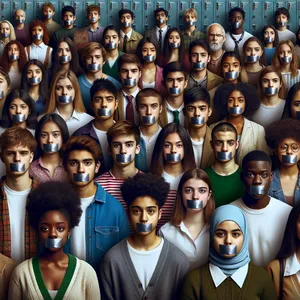Unraveling the Silence: Purpose, Impact, and Evolution
The Day of Silence stands as a symbol of resistance and a call for change. Originating from a student-led initiative, it has grown into a global observance, gaining momentum with each passing year. This section explores the foundational goals of the Day of Silence, its growing influence across schools and communities worldwide, and how it continues to evolve in response to the changing landscape of LGBTQ+ rights and advocacy.
The Day of Silence, observed annually, is more than just a call for reflection; it is a movement aimed at bringing to light the silencing and bullying faced by LGBTQ+ students in educational settings. This tradition of silence is not about non-action; rather, it is a powerful form of protest against the ongoing discrimination and harassment experienced by LGBTQ+ individuals. By choosing silence, participants vividly demonstrate the effects of erasure and marginalization, making a bold statement on the need for safe, inclusive environments for all students. Over the years, the Day of Silence has evolved from a small college initiative into a widespread act of solidarity that spans across nations, involving thousands of students, educators, and allies who stand together in silence. This evolution speaks volumes about the growing recognition of LGBTQ+ rights as a global issue, necessitating concerted efforts towards fostering understanding, respect, and equality. Additionally, the Day of Silence serves as a catalyst for dialogue and education, prompting discussions on gender, sexuality, and human rights in classrooms, online forums, and community gatherings. These conversations are critical in dismantling stereotypes, challenging prejudices, and advancing social change. Nonetheless, the Day of Silence is not without its critics. Some argue that silence, by nature, is passive and does not directly address the issues at hand. Others raise concerns about the potential for backlash, noting instances where participants have faced hostility or misunderstanding. Despite these challenges, the Day of Silence persists as a testament to the strength and resilience of the LGBTQ+ community and its allies. Furthermore, the day highlights the importance of allyship, showing that support can take many forms, including the conscious choice to step back, listen, and acknowledge the experiences of those who are often silenced. As the Day of Silence continues to grow, it reflects the ongoing struggle for LGBTQ+ rights and the vital role of youth activism in shaping a more inclusive and equitable society.
Explore More
The Day of Silence encapsulates the ongoing fight for LGBTQ+ rights, emphasizing both the power of collective action and the significance of individual voices. By embracing silence, participants draw attention to the systemic issues of bullying and discrimination, igniting conversations that can lead to real change. As we reflect on the recent observance of this day, let us remember the importance of advocacy, allyship, and the continuous journey towards equality and acceptance.
